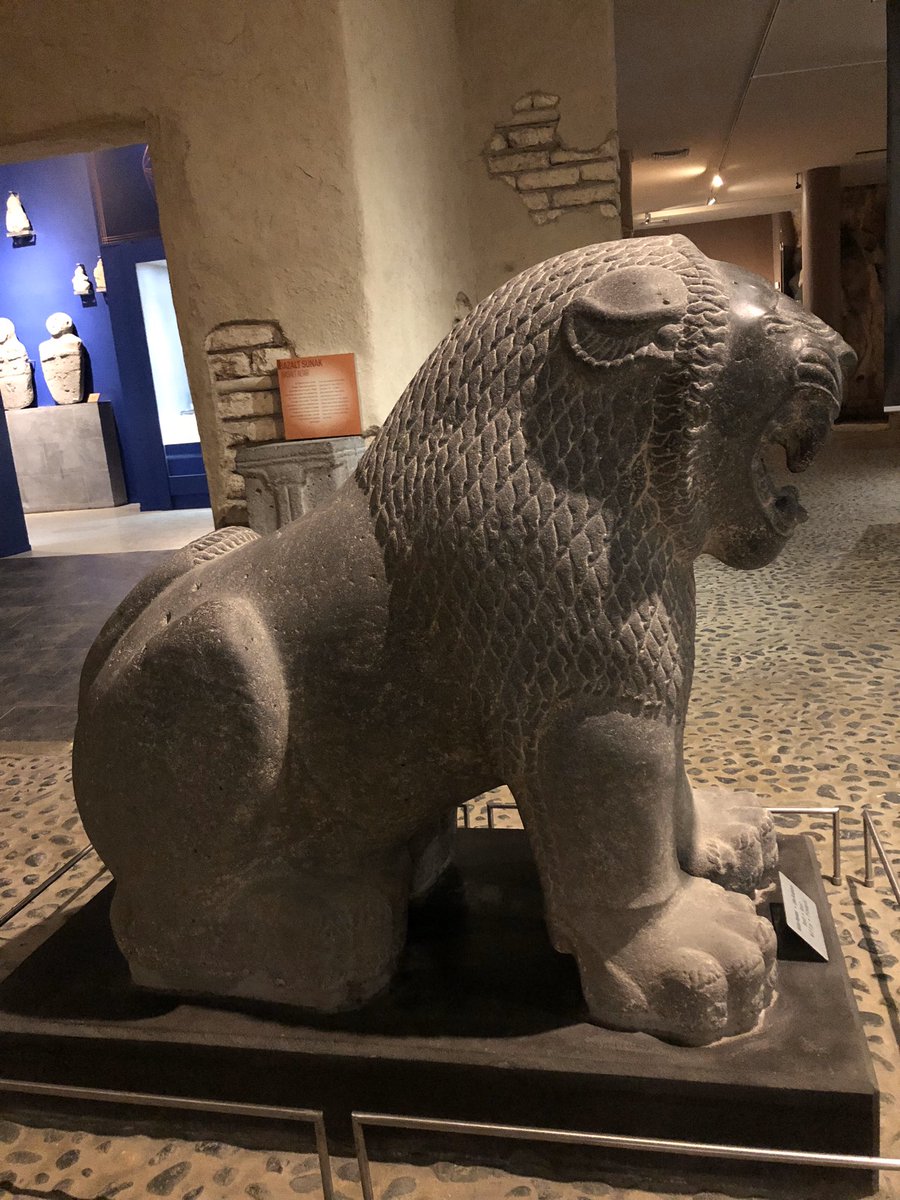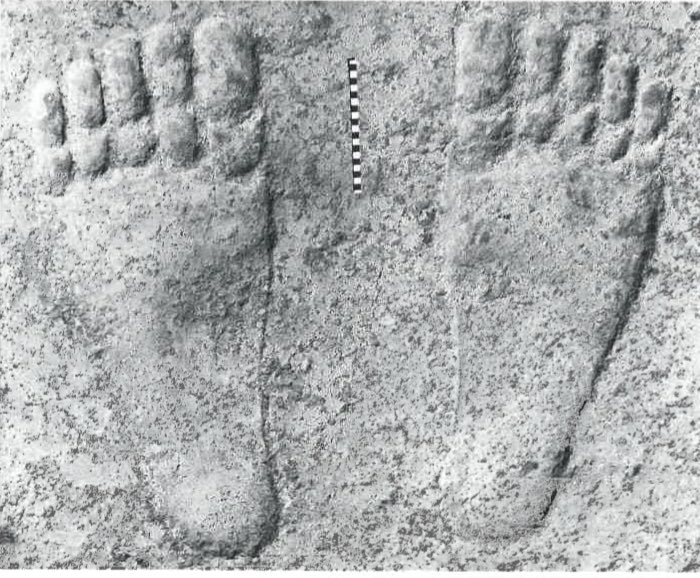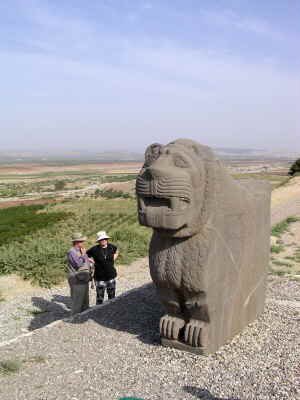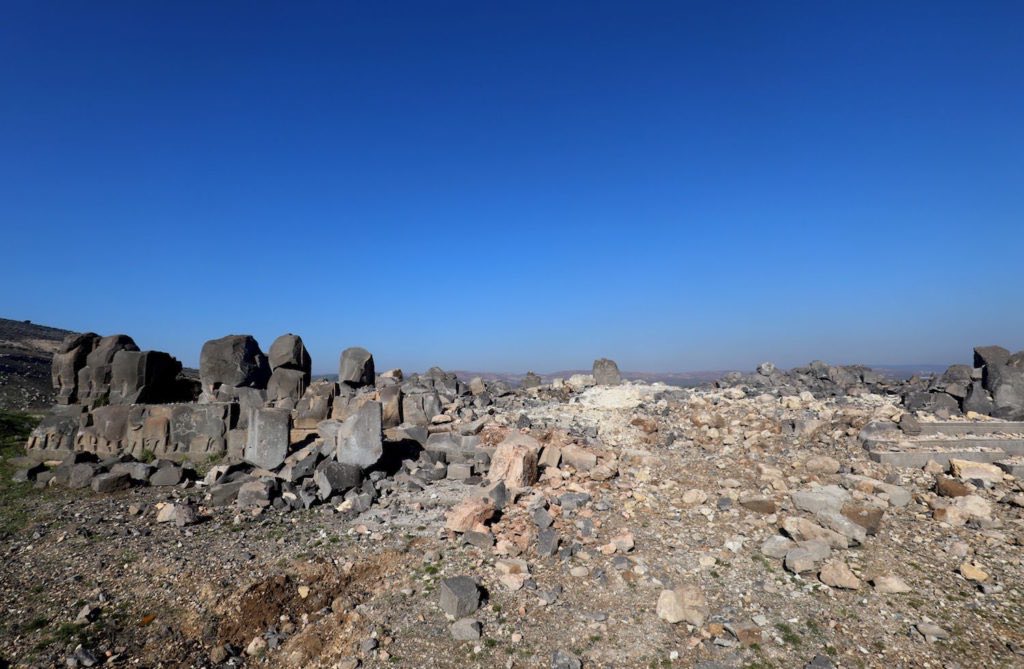
LONG ARCHAEOLOGY THREAD. I’ll be talking about the underrepresented life of the Lion of ‘Ain Dārā (Afrin Valley, Syria): Its discovery, unique design, and eventual looting. This is a case very close to my heart, so hope you enjoy and take interest! (1) 

The temple of ‘Ain Dārā was only unearthed after the chance discovery of this colossal portal lion sculpture by a shepherd in 1954. By then, only the lion’s head was visible, and after preliminary excavations, the portal lion was found to have fallen on its side in antiquity. (2) 

Further investigations unearthed two other unfinished portal lions lying side-by-side right next to it. (3) 

All three sculptures were found within the vicinity of the ‘Ain Dārā temple, a magnificent structure with a unique display of sphinx and lion sculptures decorating it from all sides. No other building has yet been discovered to bear a parallel to the temple. (4) 

And here are snippets of the various beautiful lion and sphinx protomes and orthostats decorating its exterior. (8) 







The closest comparison at least regarding the large number of sculptures would be the Late Bronze/Early Iron Age quarry of Yesemek. (9) 

Some theories propose this quarry was prepping for a similar project as that of ‘Ain Dārā, as it also included sphinxes and lion protomes. Others confirm it as a quarry that ‘delivered’ unfinished sculptures to their final destinations. (10) 

Unfortunately, the Lion of ‘Ain Dārā has not been popular in academic writing despite its unique design. E.g. I am yet to find a text that gives me its dimensions! It’s height definitely exceeds 3 m. (12) 

Estimated to have been created between 1,300 and 1,000 BCE, this portal lion carries with it much inspiration from the sculptural traditions of the Hittite Empire. However, we also need to emphasize it as a local production of the Syro-Anatolian region in the early Iron Age. (14) 

Here are some illustrations I did of its details for my research on Syro Anatolian portal lions. (15) 





Similar examples I will be talking about separately and soon are the colossal lions of Hama and that of Tell Ta’yinat. (16) 



I still cannot wrap my head around the reasons why, but some decisions (or lack thereof) were made to keep the lion of ‘Ain Dārā on site instead of transporting it to a museum nearby. It was left to the elements. And naturally, that spelled out its end... (18) 

It started in January 2018, when T*^%sh military airstrikes led to the almost total destruction of the temple of ‘Ain Dārā. I cannot emphasize enough on the cultural and archaeological losses suffered. (19) 

Part of the losses included the unique divine footprints marking the entrance of a goddess into the temple. (Early signage for any semiotics buffs). (20) 





I tried to ask then, but no one had any answers to the fate of the Lion. And then I found out in December 2019 that it had been violently looted from the site along with other sculptures that were plucked right out of the ground. (22) 



Photos surfaced of the lion sculpture having been bulldozed, and being measured (to send to potential buyers?) Many speculated that maybe it is a new lion dug up, but I have studied this piece down to the tiniest detail, and confirm it is the original one. (23) 

The lion was stolen by terrorist factions, and is now rumored to be somewhere in Turkey. However, no further sightings or confirmed information has surfaced on it yet. (24)
Unless it was cut up into smaller pieces (something looters are famed for doing for easier transportation and more sales), the lion will resurface someday, many years from now, maybe in the auction halls of the world’s leading auction houses. (25)
Maybe in the garden of an official. Maybe in the secret illegal collections of many ‘art’ collectors. The Black market. You name it. Whatever the outcome, the ‘Ain Dārā lion has to be red-listed and its sightings carefully monitored. (26)
And I’ll be waiting its resurfacing. When I see it, and I know I will, I’ll sure as hell fight to my last breath to bring it back. (27)
The only good (?) news out of this is that the ‘Ain Dārā lion has already been turned into a 3D rendering on @Sketchfab . I’ve recorded a short video for you all to see, but here’s the link anyway: sketchfab.com/3d-models/ain-…
(28)
(28)
Most of my info and photos were taken from the articles and book of Ali Abu ‘Assaf, prominent Syrian archaeologist and one of the original excavators of ‘Ain Dārā. Professor Abu Assaf passed away shortly after the first destructions of the temple. (29)
References:
Abu Assaf, Ali. 1990. Der Tempel von ‘Ain Dārā.
1993. Der Tempel von ‘Ain Dārā in Nordsyrien. Antike Welt, 24:2 (155-171)
Novák, Mirko. 2012. The Temple of ‘Ain Dārā in the Context of Imperial and Neo-Hittite Architecture and Art. IN Temple Building (...) (30)
Abu Assaf, Ali. 1990. Der Tempel von ‘Ain Dārā.
1993. Der Tempel von ‘Ain Dārā in Nordsyrien. Antike Welt, 24:2 (155-171)
Novák, Mirko. 2012. The Temple of ‘Ain Dārā in the Context of Imperial and Neo-Hittite Architecture and Art. IN Temple Building (...) (30)
Any questions or any tips on the whereabouts of the ‘Ain Dārā Lion? Hit me up! (31)
• • •
Missing some Tweet in this thread? You can try to
force a refresh




























